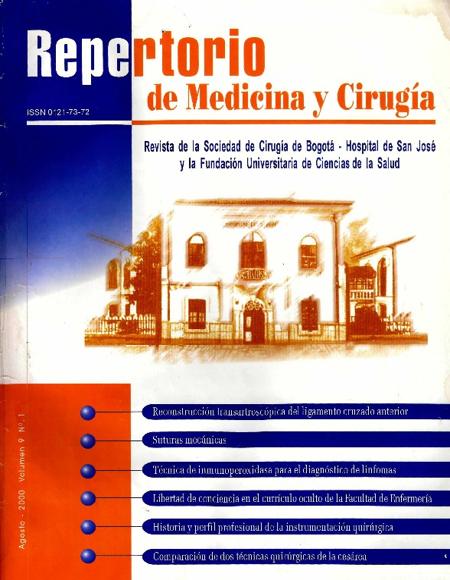Comparison of two surgical techniques of caesarean section
Comparación de dos técnicas quirúrgicas de la cesárea
![]()
![]()

Show authors biography
Randomized clinical study comparing two cesarean section techniques in patients of the Obstetrics Service of the Hospital of San José (Bogotá), during the period between January 1998 and June 1999. Of the patients with cesarean section indication, 100 were selected randomly. they entered two groups: group 1 (n = 50), the traditional technique was performed (Hhisterorrhaphy in two planes with closure of both peritoneums) and in group 2 (n = 50), the technique in monoplane (hysterorrhaphy in one flat without visceral or parietal peritoneum closure). The surgical time used, intraoperative bleeding, the amount of suture material used, pain and complications in the immediate postoperative period were evaluated. The average age was 25.48 ± 5.5 years in group 1 (G1) and 27.5 ± 7.4 years in group 2 (G2), (p = 0.38 NS). In group 1, 37.5% were primigestante and 34.3% in group 2 (p = 0.8 NS). Statistically significant differences were found between the two groups: Group 2 (G2) showed a reduction in surgical time (G2: 30.3 ± 5.6 minutes vs Gl: 42.7 ± 7.3 minutes, p <0.01), decrease of intraoperative bleeding (G2: 337 + 97 cc vs Gl: 475 ± 54 cc, p <0.001), lower amount of absorbable sutures used in G2: Median of 3, significantly lower than the median of G1 = 5. The median of the postoperative pain intensity referred by the members of the G2 was 5, significantly lower than in the Gl, where it was 6 (p <0.01). No differences were found regarding the average length of hospital stay and postoperative complications were not present. It is suggested to continue the study to monitor patients and determine long-term complications, as well as their impact on morbidity and the obstetric future
Article visits 547 | PDF visits 2977
Downloads
1. Cunningham, Mac Donald, Gant Leveno. William's Obstetrics; 41 edición. Masson S.A., Barcelona, España, 585 -90.
2. Hauth JC, Owen J. Transverse Uterine Incision Closure : One versus two layer. AmJ Obstet Gynecol. 1992 Oct; 167(4): 1108-11.
3. Federici D, Lacelly B. Cesarean Section using the Misgay Ladach method. Int J Gynaecol Obstet. 1997; 57(3): 273- 79.
4. Alonso P Walker. Peritoneo Peritonitis y Abscesos Intraabdominales En: Schwars Principios de Cirugía General. Editorial MGH; 1303- 1307.
5. Ellis H & Reddle R. Does the Peritoneum to be closed at laparotomy. Brit J Surg, 1 1977; 164: 733-6.
6. Sanders, DiClementi. Principies of abdominal wound closure II. Prevention ofwounddehiscence. Arch Surg. 1997; 112(10): 1188-91.
7. Hull DB, Varner NW. A randomized study of closure of the peritoneum at cesarean delivery, Obst Gynecol 1991; 77(6): 818- 21.
8. Pietrantoni M, -Parsons MT, O'Brien WF, Collins E, Knuppel RA, Spellacy WN. Peritoneal closure or non-closure at cesarean. Obstet Gynecol. 1991; 77(2):293-6.
9. Nagele F, Karas H, Spitzer D, Staudach A, Karasegh S, Beck A, Husslein P. Closure or nonclosure of the visceral peritoneum at cesarean delivery. Am J Obstet Gynecol. 1996;174(4):1366-70.
10. McNally O. Does closure of the peritoneum duringZesarean section influence postoperative morbidity and subsequent bladder adhesion. J Obstet Gynecol, 1997.
11. Stark M. Technique of caesarean section: The Misgay Ladach method. Women's Health Today. XIV World Congress of Gynecology and Obstetrics at Montreal. September 1994. si - 85.
12. Hojberg KE, Aagaard J, Laursen H, Diab L, Secher NJ . Closure versus non -closure of peritoneum at cesarean section. Evaluation of pain. A randomized study . Acta Obstet Gynecol Scand. 1998;77 ( 7): 741-5.
13. Chapman SJ, Owen J, Hauth JC. One versus two-layer closure of a low transverse cesarean: the next pregnancy. Obstet Gynecol. 1997; 89: (1)16-8.
14. Tucker JM, Hauth JC, Hodgins P, Owen J, Winkler JL. Trial of labor after a one or two layer closure of a low transverse uterine incision. Am J Obstet Gynecol. 1993; 168(2): 545-6.
15. Obel J, Younis JS, Lang N, Levit A. Double-layer closure of uterine incision with visceral and parietal peritoneal closure: are they obligatory steps of routline cesarean sections? J Matern Fetal Med. 1996 Nov-Dec; 5(6): 366-9.
16. Karipineni RC, Wilk PJ, Danese CA. The role of the peritoneum in the healing of abdominal incisions. Surg Gyn Obstet. 1976; 142(5): 729-30.
17. Irion O, Luzuy F, Beguin E Nonclosure of visceral and parietal peritoneum at cesarean section: a randomized controlled trial. Br J Obstet Gynaecol. 1996 Jul; 103(7): 690-4.
18. Pridjian G, Hibbard JU, Moawad AH. Cesarean: Changing the trends. Obstet Gynecol. 1991; 77(2): 195-200.













